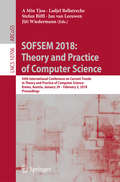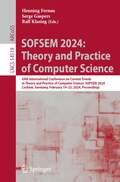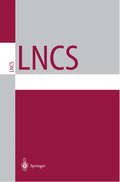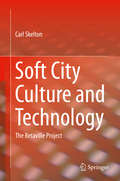- Table View
- List View
SOFSEM 2007: 33nd Conference on Current Trends in Theory and Practice of Computer Science, Harrachov, Czech Republic, January 20-26, 2007, Proceedings (Lecture Notes in Computer Science #4362)
by Jan Van Leeuwen Frantisek Plásil Giuseppe F. Italiano Wiebe Van Der Hoek Christoph Meinel Harald SackThis book constitutes the refereed proceedings of the 33rd Conference on Current Trends in Theory and Practice of Computer Science, SOFSEM 2007, held in Harrachov, Czech Republic in January 2007. The 69 revised full papers, presented together with 11 invited contributions were carefully reviewed and selected from 283 submissions. The papers were organized in four topical tracks.
SOFSEM 2008: 34th Conference on Current Trends in Theory and Practice of Computer Science, Nový Smokovec, Slovakia, January 19-25, 2008, Proceedings (Lecture Notes in Computer Science #4910)
by Villiam Geffert Juhani Karhumäki Alberto Bertoni Bart Preneel Pavol Návrat Mária BielikováThis book constitutes the refereed proceedings of the 34th Conference on Current Trends in Theory and Practice of Computer Science, SOFSEM 2008, held in Slovakia, in 2008. The 57 revised full papers, presented together with 10 invited contributions, were carefully reviewed and selected from 162 submissions. The contributions are segmented into four topical sections on foundations of computer science; computing by nature; networks, security, and cryptography; and Web technologies.
SOFSEM 2009: 35th Conference on Current Trends in Theory and Practice of Computer Science, Špindleruv Mlýn, Czech Republic, January 24-30, 2009. Proceedings (Lecture Notes in Computer Science #5404)
by Peter Bro Miltersen Catuscia Palamidessi Petr Tuma Frank Valencia Mogens Nielsen Antonin KuceraThis book constitutes the refereed proceedings of the 35th Conference on Current Trends in Theory and Practice of Computer Science, SOFSEM 2009, held in Špindleruv Mlýn, Czech Republic, in January 2009. The 49 revised full papers, presented together with 9 invited contributions, were carefully reviewed and selected from 132 submissions. SOFSEM 2009 was organized around the following four tracks: Foundations of Computer Science; Theory and Practice of Software Services; Game Theoretic Aspects of E-commerce; and Techniques and Tools for Formal Verification.
SOFSEM 2010: 36th Conference on Current Trends in Theory and Practice of Computer Science, Špindleruv Mlýn, Czech Republic, January 23-29, 2010. Proceedings (Lecture Notes in Computer Science #5901)
by Jaroslav Pokorny Bernhard Rumpe Jan Van Leeuwen Anca Muscholl David PelegSOFSEM 2011: 37th Conference on Current Trends in Theory and Practice of Computer Science, Nový Smokovec, Slovakia, January 22-28, 2011. Proceedings (Lecture Notes in Computer Science #6543)
by Ivana Cerná Tibor Gyimóthy Juraj Hromkovi 269 Keith Jeffery Rastislav Kralovic Marko Vukolic Stefan WolfThis book constitutes the refereed proceedings of the 37th Conference on Current Trends in Theory and Practice of Computer Science, SOFSEM 2011, held in Nový, Smokovec, Slovakia in January 2011. The 41 revised full papers, presented together with 5 invited contributions, were carefully reviewed and selected from 122 submissions. SOFSEM 2011 was organized around the following four tracks: foundations of computer science; software, systems, and services; processing large datasets; and cryptography, security, and trust.
SOFSEM 2012: 38th Conference on Current Trends in Theory and Practice of Computer Science, Špindlerův Mlýn, Czech Republic, January 21-27, 2012, Proceedings (Lecture Notes in Computer Science #7147)
by Maria Bielikova György Turán Gerhard Friedrich Georg Gottlob Stefan KatzenbeisserThis book constitutes the refereed proceedings of the 38th Conference on Current Trends in Theory and Practice of Computer Science, SOFSEM 2012, held in Špindlerův Mlýn, Czech Republic, in January 2012. The 43 revised papers presented in this volume were carefully reviewed and selected from 121 submissions. The book also contains 11 invited talks, 10 of which are in full-paper length. The contributions are organized in topical sections named: foundations of computer science; software and Web engineering; cryptography, security, and verification; and artificial intelligence.
SOFSEM 2013: 39th International Conference on Current Trends in Theory and Practice of Computer Science, Špindlerův Mlýn, Czech Republic, January 26-31, 2013, Proceedings (Lecture Notes in Computer Science #7741)
by Peter Van Emde Boas Frans C. A. Groen Giuseppe F. Italiano Jerzy Nawrocki Harald SackThis book constitutes the refereed proceedings of the 39th International Conference on Current Trends in Theory and Practice of Computer Science, SOFSEM 2013, held in Špindlerův Mlýn, Czech Republic, in January 2013. The 37 revised full papers presented in this volume were carefully reviewed and selected from 98 submissions. The book also contains 10 invited talks, 5 of which are in full-paper length. The contributions are organized in topical sections named: foundations of computer science; software and Web engineering; data, information, and knowledge engineering; and social computing and human factors.
SOFSEM 2014: 40th International Conference on Current Trends in Theory and Practice of Computer Science,Nový Smokovec, Slovakia, January 26-29, 2014, Proceedings (Lecture Notes in Computer Science #8327)
by Viliam Geffert Bart Preneel Branislav Rovan Július Stuller A. Min TjoaThis book constitutes the refereed proceedings of the 40th International Conference on Current Trends in Theory and Practice of Computer Science, SOFSEM 2014, held in Nový Smokovec, Slovakia, in January 2014. The 40 revised full papers presented in this volume were carefully reviewed and selected from 104 submissions. The book also contains 6 invited talks. The contributions covers topics as: Foundations of Computer Science, Software and Web Engineering, as well as Data, Information and Knowledge Engineering and Cryptography, Security and Verification.
SOFSEM 2015: 41st International Conference on Current Trends in Theory and Practice of Computer Science, Pec pod Sněžkou, Czech Republic, January 24-29, 2015, Proceedings (Lecture Notes in Computer Science #8939)
by Giuseppe F. Italiano Tiziana Margaria-Steffen Jaroslav Pokorný Jean-Jacques Quisquater Roger WattenhoferThis book constitutes the proceedings of the 41st International Conference on Current Trends in Theory and Practice of Computer Science held in Pec pod Sněžkou, Czech Republic, during January 24-29, 2015. The book features 8 invited talks and 42 regular papers which were carefully reviewed and selected from 101 submissions. The papers are organized in topical sections named: foundations of computer science; software and Web engineering; data, information, and knowledge engineering; and cryptography, security, and verification.
SOFSEM 2016: 42nd International Conference on Current Trends in Theory and Practice of Computer Science, Harrachov, Czech Republic, January 23-28, 2016, Proceedings (Lecture Notes in Computer Science #9587)
by Rūsiņš Mārtiņš Freivalds Gregor Engels Barbara CataniaThis book constitutes the proceedings of the 42nd International Conference on Current Trends in Theory and Practice of Computer Science, SOFSEM 2016, held in Harrachov, Czech Republic, in January 2016.The 43 full papers presented in this volume were carefully reviewed and selected from 116 submissions. They are organized in topical sections named: foundations of computer science; software engineering: methods, tools, applications; and data, information, and knowledge engineering. The volume also contains 7 invited talks in full paper length.
SOFSEM 2017: 43rd International Conference on Current Trends in Theory and Practice of Computer Science, Limerick, Ireland, January 16-20, 2017, Proceedings (Lecture Notes in Computer Science #10139)
by Bernhard Steffen Christel Baier Mark van den Brand Johann Eder Mike Hinchey Tiziana MargariaThis book constitutes the refereed proceedings of the 43rd International Conference on Current Trends in Theory and Practice of Computer Science, SOFSEM 2017, held in Limerick, Ireland, in January 2017. The 34 papers presented in this volume were carefully reviewed and selected from 41 submissions. They were organized in topical sections named: foundations in computer science; semantics, specification and compositionality; theory of mobile and distributed systems; verification and automated system analysis; petri nets, games and relaxed data structures; graph theory and scheduling algorithms; quantum and matrix algorithms; planar and molecular graphs; coloring and vertex covers; algorithms for strings and formal languages; data, information and knowledge engineering; and software engineering: methods, tools, applications.
SOFSEM 2018: 44th International Conference on Current Trends in Theory and Practice of Computer Science, Krems, Austria, January 29 - February 2, 2018, Proceedings (Lecture Notes in Computer Science #10706)
by A Min Tjoa Ladjel Bellatreche Stefan Biffl Jan Van Leeuwen Jiří WiedermannThis book constitutes the refereed proceedings of the 44th International Conference on Current Trends in Theory and Practice of Computer Science, SOFSEM 2018, held in Krems, Austria, in January/February 2018. The 48 papers presented in this volume were carefully reviewed and selected from 97 submissions. They were organized in topical sections named: foundations of computer science; software engineering: advances methods, applications, and tools; data, information and knowledge engineering; network science and parameterized complexity; model-based software engineering; computational models and complexity; software quality assurance and transformation; graph structure and computation; business processes, protocols, and mobile networks; mobile robots and server systems; automata, complexity, completeness; recognition and generation; optimization, probabilistic analysis, and sorting; filters, configurations, and picture encoding; machine learning; text searching algorithms; and data model engineering.
SOFSEM 2019: 45th International Conference on Current Trends in Theory and Practice of Computer Science, Nový Smokovec, Slovakia, January 27-30, 2019, Proceedings (Lecture Notes in Computer Science #11376)
by Barbara Catania Rastislav Královič Jerzy Nawrocki Giovanni PighizziniThis book constitutes the refereed proceedings of the 45th International Conference on Current Trends in Theory and Practice of Computer Science, SOFSEM 2019, held in Nový Smokovec, Slovakia, in January 2019. The 34 full papers presented together with 6 invited talks were carefully reviewed and selected from 92 submissions. They presented new research results in the theory and practice of computer science in the each sub-area of SOFSEM 2019: Foundations of theoretical Computer Science, foundations of data science and engineering, and foundations of software engineering.
SOFSEM 2020: 46th International Conference on Current Trends in Theory and Practice of Informatics, SOFSEM 2020, Limassol, Cyprus, January 20–24, 2020, Proceedings (Lecture Notes in Computer Science #12011)
by Alexander Chatzigeorgiou Riccardo Dondi Herodotos Herodotou Christos Kapoutsis Yannis Manolopoulos George A. Papadopoulos Florian SikoraThis book constitutes the refereed proceedings of the 46th International Conference on Current Trends in Theory and Practice of Informatics, SOFSEM 2020, held in Limassol, Cyprus, in January 2020. The 40 full papers presented together with 17 short papers and 3 invited papers were carefully reviewed and selected from 125 submissions. They presented new research results in the theory and practice of computer science in the each sub-area of SOFSEM 2020: foundations of computer science, foundations of data science and engineering, foundations of software engineering, and foundations of algorithmic computational biology.
SOFSEM 2021: 47th International Conference on Current Trends in Theory and Practice of Computer Science, SOFSEM 2021, Bolzano-Bozen, Italy, January 25–29, 2021, Proceedings (Lecture Notes in Computer Science #12607)
by Tomáš Bureš Riccardo Dondi Johann Gamper Giovanna Guerrini Tomasz Jurdziński Claus Pahl Florian Sikora Prudence W. H. WongThis book contains the invited and contributed papers selected for presentation at SOFSEM 2021, the 47th International Conference on Current Trends in Theory and Practice of Computer Science, which was held online during January 25–28, 2021, hosted by the Free University of Bozen-Bolzano, Italy.The 33 full and 7 short papers included in the volume were carefully reviewed and selected from 100 submissions. They were organized in topical sections on: foundations of computer science; foundations of software engineering; foundations of data science and engineering; and foundations of algorithmic computational biology. The book also contains 5 invited papers.
SOFSEM 2023: 48th International Conference on Current Trends in Theory and Practice of Computer Science, SOFSEM 2023, Nový Smokovec, Slovakia, January 15–18, 2023, Proceedings (Lecture Notes in Computer Science #13878)
by Leszek GąsieniecThis book constitutes the conference proceedings of the 48th International Conference on Current Trends in Theory and Practice of Computer Science, SOFSEM 2023, held in Nový Smokovec, Slovakia, during January 15–18, 2023.The 22 full papers presented together with 2 best papers and 2 best students papers in this book were carefully reviewed and selected from 43 submissions.This workshop focuses on graphs problems and optimization; graph drawing and visualization; NP-hardness and fixed parameter tractability; communication and temporal graphs; complexity and learning; and robots and strings.
SOFSEM 2024: 49th International Conference on Current Trends in Theory and Practice of Computer Science, SOFSEM 2024, Cochem, Germany, February 19–23, 2024, Proceedings (Lecture Notes in Computer Science #14519)
by Henning Fernau Serge Gaspers Ralf KlasingThis book constitutes the proceedings of the 49th International Conference on Current Trends in Theory and Practice of Computer Science, SOFSEM 2024, held in Cochem, Germany, in February 2024. The 33 full papers presented in this book were carefully reviewed and selected from 81 submissions. The book also contains one invited talk in full paper length. They focus on original research and challenges in foundations of computer science including algorithms, AI-based methods, computational complexity, and formal models.
SOFSEM '98: 25th Conference on Current Trends in Theory and Practice of Informatics, Jasna, Slovakia, November 21-27, 1998 Proceedings (Lecture Notes in Computer Science #1521)
by Branislav RovanSOFSEM'99: 26th Conference on Current Trends in Theory and Practice of Informatics, Milovy, Czech Republic, November 27 - December 4, 1999 Proceedings (Lecture Notes in Computer Science #1725)
by Jan Pavelka Gerard Tel Miroslav BartosekThis year the SOFSEM conference is coming back to Milovy in Moravia to th be held for the 26 time. Although born as a local Czechoslovak event 25 years ago SOFSEM did not miss the opportunity oe red in 1989 by the newly found freedom in our part of Europe and has evolved into a full-?edged international conference. For all the changes, however, it has kept its generalist and mul- disciplinarycharacter.Thetracksofinvitedtalks,rangingfromTrendsinTheory to Software and Information Engineering, attest to this. Apart from the topics mentioned above, SOFSEM’99 oer s invited talks exploring core technologies, talks tracing the path from data to knowledge, and those describing a wide variety of applications. TherichcollectionofinvitedtalkspresentsonetraditionalfacetofSOFSEM: that of a winter school, in which IT researchers and professionals get an opp- tunity to see more of the large pasture of today’s computing than just their favourite grazing corner. To facilitate this purpose the prominent researchers delivering invited talks usually start with a broad overview of the state of the art in a wider area and then gradually focus on their particular subject.
Soft City Culture and Technology: The Betaville Project
by Carl SkeltonSoft City Culture and Technology: The Betaville Project discusses the complete cycle of conception, development, and deployment of the Betaville platform.Betaville is a massively participatory online environment for distributed 3D design and development of proposals for changes to the built environment– an experimental integration of art, design, and software development for the public realm. Through a detailed account of Betaville from a Big Crazy Idea to a working "deep social medium", the author examines the current conditions of performance and accessibility of hardware, software, networks, and skills that can be brought together into a new form of open public design and deliberation space, for and spanning and integrating the disparate spheres of art, architecture, social media, and engineering.Betaville is an ambitious enterprise, of building compelling and constructive working relationships in situations where roles and disciplinary boundaries must be as agile as the development process of the software itself. Through a considered account and analysis of the interdependencies between Betaville's project design, development methods, and deployment, the reader can gain a deeper understanding of the potential socio-technical forms of New Soft Cities: blended virtual-physical worlds, whose "public works" must ultimately serve and succeed as massively collaborative works of art and infrastructure.
Soft Commutation Isolated DC-DC Converters (Power Systems)
by Ivo Barbi Fabiana PöttkerThis book describes the operation and analysis of soft-commutated isolated DC–DC converters used in the design of high efficiency and high power density equipment. It explains the basic principles behind first- and second-order circuits with power switches to enable readers to understand the importance of these converters in high efficiency and high power density power supply design for residential, commercial, industrial and medical use as well as in aerospace equipment.With each chapter featuring a different power converter topology, the book covers the most important resonant converters, including series resonant converters; resonant LLC converters; soft commutation pulse width modulation converters; zero voltage switching; and zero current switching. Each topic is presented with full analysis, a showcase of the power stages of the converters, exercises and their solutions as well as simulation results, which mainly focus on the commutation analysis and output characteristic.This book is a valuable source of information for professionals working in power electronics, power conversion and design of high efficiency and high power density DC–DC converters and switch mode power supplies. The book also serves as a point of reference for engineers responsible for development projects and equipment in companies and research centers and a text for advanced students.
Soft Computing: Techniques and its Applications in Electrical Engineering (Studies in Computational Intelligence #103)
by Devendra K. ChaturvediThis book is an introduction to some new fields in soft computing with its principal components of fuzzy logic, ANN and EA. The approach in this book is to provide an understanding of the soft computing field and to work through soft computing using examples. It also aims to integrate pseudo-code operational summaries and Matlab codes, to present computer simulation, to include real world applications and to highlight the distinctive work of human consciousness in machine.
Soft Computing: Recent Advances and Applications in Engineering and Mathematical Sciences (Edge AI in Future Computing)
by Pradip Debnath Oscar Castillo Poom KumamThis book explores soft computing techniques in a systematic manner starting from their initial stage to recent developments in this area. The book presents a survey of the existing knowledge and the current state-of-the-art development through cutting-edge original new contributions from the researchers. Soft Computing: Recent Advances and Applications in Engineering and Mathematical Sciences presents a survey of the existing knowledge and the current state-of-the-art development through cutting-edge original new contributions from the researchers. As suggested by the title, this book particularly focuses on the recent advances and applications of soft computing techniques in engineering and mathematical sciences. Chapter 1 describes the contribution of soft computing techniques towards a new paradigm shift. The subsequent chapters present a systematic application of fuzzy logic in mathematical sciences and decision-making. New research directions are also provided at the end of each chapter. The application of soft computing in health sciences and in the modeling of epidemics including the effects of vaccination are also examined. Sustainability of green product development, optimum design of 3D steel frame, digitalization investment analysis in the maritime industry, forecasting return rates of individual pension funds are among some of the topics where engineering and industrial applications of soft computing have been studied in the book. The readers of this book will require minimum prerequisites of undergraduate studies in computation and mathematics. This book is meant for graduate students, faculty, and researchers who are applying soft computing in engineering and mathematics. New research directions are also provided at the end of each chapter.
Soft Computing: Recent Advances and Applications in Engineering and Mathematical Sciences (Edge AI in Future Computing)
by Pradip Debnath Sushil Kumar Solanki Oscar Castillo Poom KumamThis book explores soft computing techniques in a systematic manner starting from their initial stage to recent developments in this area. The book presents a survey of the existing knowledge and the current state-of-the-art development through cutting-edge original new contributions from the researchers. Soft Computing: Recent Advances and Applications in Engineering and Mathematical Sciences presents a survey of the existing knowledge and the current state-of-the-art development through cutting-edge original new contributions from the researchers. As suggested by the title, this book particularly focuses on the recent advances and applications of soft computing techniques in engineering and mathematical sciences. Chapter 1 describes the contribution of soft computing techniques towards a new paradigm shift. The subsequent chapters present a systematic application of fuzzy logic in mathematical sciences and decision-making. New research directions are also provided at the end of each chapter. The application of soft computing in health sciences and in the modeling of epidemics including the effects of vaccination are also examined. Sustainability of green product development, optimum design of 3D steel frame, digitalization investment analysis in the maritime industry, forecasting return rates of individual pension funds are among some of the topics where engineering and industrial applications of soft computing have been studied in the book. The readers of this book will require minimum prerequisites of undergraduate studies in computation and mathematics. This book is meant for graduate students, faculty, and researchers who are applying soft computing in engineering and mathematics. New research directions are also provided at the end of each chapter.
Soft Computing: Engineering Applications (ISSN)
by Pradip Debnath Binod Chandra TripathyThis book examines the latest developments in the area of soft computing with engineering applications. It explores topics such as fuzzy sets, intuitionistic fuzzy sets, unmanned aerial vehicles, soft sets, neutrosophic sets, fractional calculus, big data analytics, and the mathematical foundations of convolutional neural network (CNNs). Soft Computing: Engineering Applications offers readers a comprehensive and in-depth understanding of various cutting-edge technologies that are transforming industries worldwide. The book explores soft computing techniques in a very systematic manner. It elucidates the concepts, theories, and applications of fuzzy sets, enabling readers to grasp the fundamentals and explore their applications in various fields. It provides new insight into unmanned aerial vehicle applications to fuzzy soft set based decision making. It then discusses new fixed point results in orthogonal neutrosophic generalized metric spaces and explores statistical convergence of triple sequences in a credibility space. The authors then provide readers with a solid grasp of the mathematical underpinnings of CNNs, enabling them to design, train, and optimize neural networks for image recognition, object detection, and other computer vision tasks. The authors also present new studies in fractional calculus and explores advanced visualization algorithms and techniques for big data analytics.Soft Computing will be useful for beginners and advanced researchers in engineering, applied sciences and healthcare professionals working in soft computing applications.























